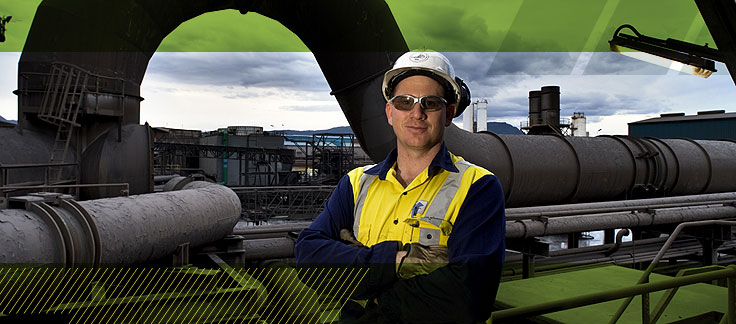Water
Case Studies
 |
|
|
Reducing Water Use at Port Kembla Basic Oxygen Steelmaking (BOS) Plant
Significant improvements in water management are saving 130 megalitres of fresh water each year at the Basic Oxygen Steelmaking (BOS) plant in Port Kembla. This has been achieved by increasing the amount of reused water taken from the Hot Strip Mill, thus decreasing the demand for fresh water.
In October 2005, a new air-conditioning cooling tower was commissioned, reducing the use of ‘once through’ fresh water for cooling and allowing the BOS to reuse more water recycled from the Hot Strip Mill.
Water meters were also installed on several critical water supplies. These meters have allowed for more accurate accounting of water use, identifying issues and assisting in the development of future water saving activities.
Water consumption at the BOS has reduced from 0.25 kilolitres per tonne of steel in mid 2005 to 0.17 kilolitres per tonne of steel in May 2006 – a 32 per cent reduction. This reduction in water use has also translated into annual cost savings of A$250,000.
Less Means More for Water Recycling Initiative at Port Kembla
A recycling initiative between BlueScope Steel and the Sydney Water Corporation is playing a major role in preserving precious water supplies, while providing a significant environmental benefit for the Illawarra region of New South Wales, Australia.
Sydney Water Corporation’s new Wollongong Sewage Treatment Plant provides up to 20 million litres of reverse osmosis recycled water a day to the Port Kembla Steelworks, replacing the same amount previously drawn from the Illawarra’s main water supply – Avon Dam.
This landmark recycling initiative was activated on 11 September 2006 by NSW Premier Morris Iemma. Said the Premier: “BlueScope Steel has taken magnificent strides in the last decade in reducing its call on drinking water.”
The project reduces the Port Kembla Steelworks’ fresh water use by more than 50 per cent. It complements an existing water reduction program that had already reduced the Steelworks’ fresh water consumption from almost 50 million litres a day to 37 million litres.
The new partnership with Sydney Water will further reduce the draw on fresh water from Avon Dam from 37 million litres a day to 17 million litres a day. In addition, 20 million litres of waste water, that would otherwise have been pumped into the ocean, will be used on the Port Kembla sites.
Heat Exchanger Reduces Water Use at CRM Service Centre Port Kembla
The installation of new water cooling equipment at Port Kembla’s CRM Service Centre has resulted in a 60 per cent reduction in fresh water use for manufacturing.
The paint coating line at the CRM Service Centre at Port Kembla produces 65,000 tonnes of painted steel each year.
Water is used to cool the steel strip as it exits the paint drying ovens. The prime coat oven used fresh water to keep the quench cooling water at the required temperature, while the finish coat oven used water recirculated from a cooling tower.
Tests showed that using the cooling tower water for the prime quench had an adverse affect on the prime coating process. An alternative solution to using cooling tower water was required.
The solution was achieved by using a heat exchanger to indirectly cool the prime quench water, and by upgrading the cooling tower system for the increased heat load.
New equipment, installed in November 2005, resulted in a daily saving of 80 kilolitres of fresh water and 65 kilolitres of effluent.
Other processes at CRM are under review to achieve the site’s objective of the lowest economically practical water use and wastewater discharge, continuing BlueScope Steel’s commitment to responsible use of resources and to the environment.
